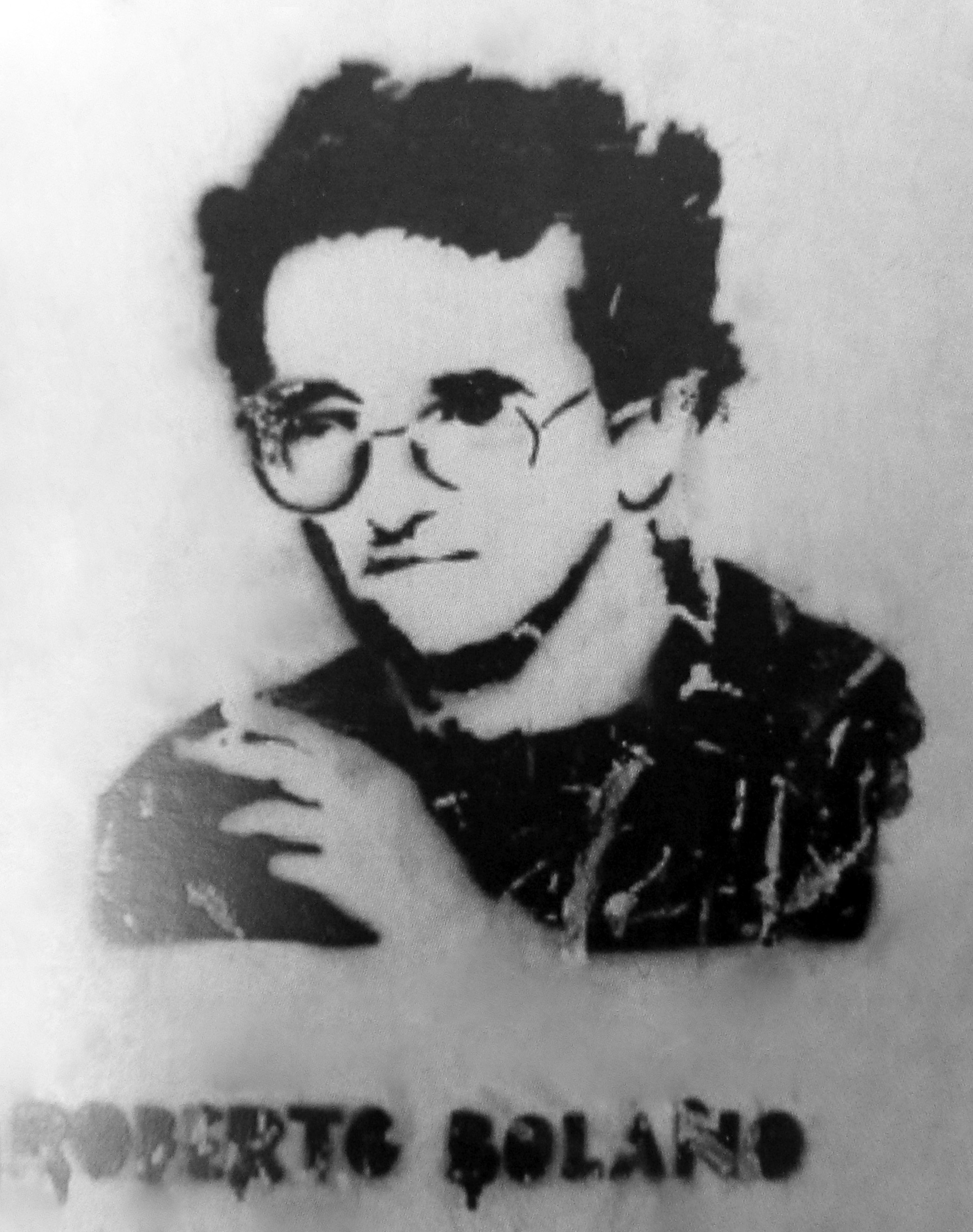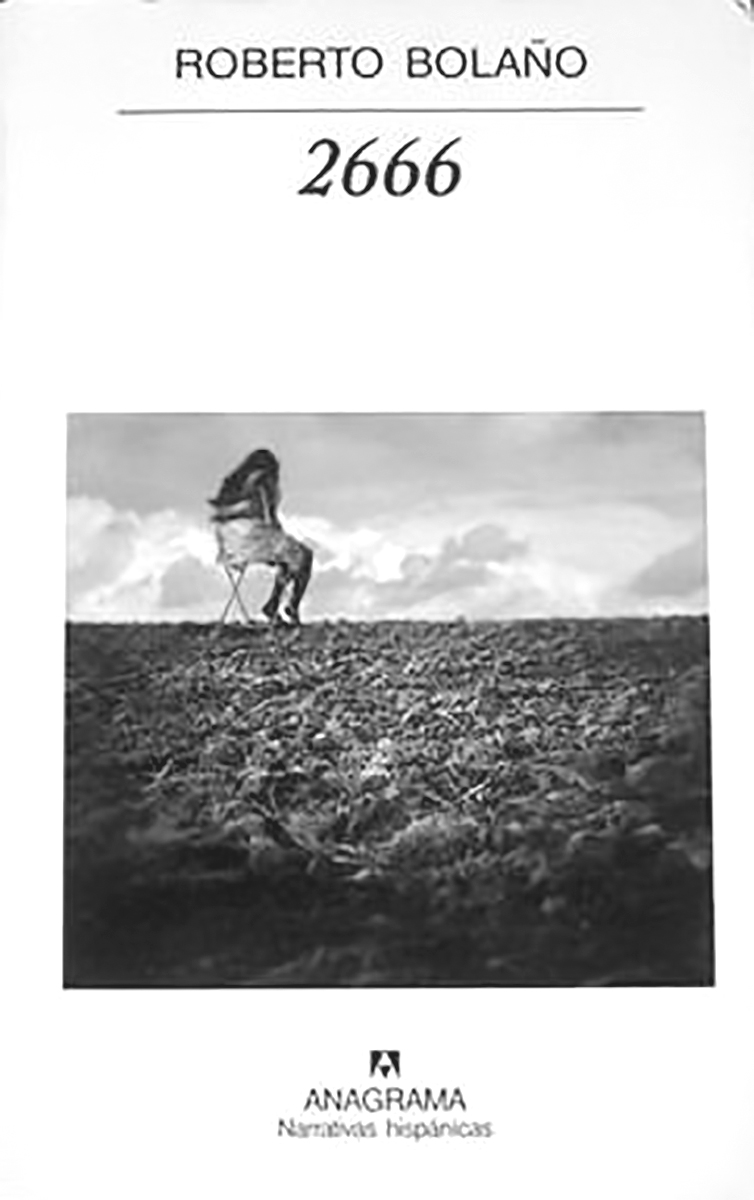Sean M. Kennedy
The fucking murders are like a strike, friend, a wild fucking strike.
— Roberto Bolaño, 2666
 In the central narrative of the late Roberto Bolaño’s sprawling novel 2666, a black U.S. sportswriter named Fate, on assignment in “Santa Teresa,” a fictional version of Ciudad Juárez, learns about an epidemic of murdered women in the border city. Breakfasting near the sports arena where a boxing match will take place, he notices everyone talking about something and asks his fixer about it. The murders of women, his compañero says, “bloom”: “Every so often…they’re news again and the journalists talk about them. People also talk about them again and the story grows like a snowball until the sun comes up and the fucking ball melts and everyone forgets and returns to work.” Fate comments on the reference to “work” and his friend goes on, saying: “The fucking murders are like a strike, friend, a wild fucking strike.” (My translations from the Spanish.)
In the central narrative of the late Roberto Bolaño’s sprawling novel 2666, a black U.S. sportswriter named Fate, on assignment in “Santa Teresa,” a fictional version of Ciudad Juárez, learns about an epidemic of murdered women in the border city. Breakfasting near the sports arena where a boxing match will take place, he notices everyone talking about something and asks his fixer about it. The murders of women, his compañero says, “bloom”: “Every so often…they’re news again and the journalists talk about them. People also talk about them again and the story grows like a snowball until the sun comes up and the fucking ball melts and everyone forgets and returns to work.” Fate comments on the reference to “work” and his friend goes on, saying: “The fucking murders are like a strike, friend, a wild fucking strike.” (My translations from the Spanish.)
Feminicide, as Bolaño suggests in 2666, is a potent way of seeing relations of labor, violence, and power, especially across the three settler states of North America, the vaunted “new world” of European empire. Moreover, following the comparison to labor striking, feminicide is a key lens through which to think the refusal to work differently, and with a greater potential for revolutionary change. By broadening the target from the wage relation to all relations of exploitation, first and foremost those structured by gender and race, which ramify the brutalities of capitalism, the world to come will have a better chance at freedom from all hierarchy and coercion.
As Bolaño makes clear in 2666, the women affected by feminicide are largely Indigenous and employed in the maquiladoras and industrial parks that sprung up in the aftermath of the North American Free Trade Agreement of 1994. As U.S. companies lowered their labor costs by outsourcing production to Mexican workers, and narco-capitalists took advantage of the liberalized economy to enhance their own companies through intimidation and fear, Indigenous and darker-skinned women bore the brunt of the bio-political carnage, toiling for sub-minimum wages in subhuman conditions when they weren’t exterminated outright.
The epidemic of murdered and missing women in Juárez, like that of women who have disappeared in the U.S. and Canada, is a contemporary iteration of the colonial scene of conquest, genocide, and enslavement. In this scene, women are always disposable. They can be used for sex or household service, field work or procreation. They can be killed because of European settlement—whether by germs or colonial militias—or through the slow violence of the Middle Passage and the plantation. And while this historical configuration of forces may have been particular to (and particularly severe in) the Americas (the Américas), versions of it played out wherever European empires vied for control, territory, and profit. Indigenous women everywhere were simultaneously the most and least valued in heteropatriarchal societies: objects that could be utilized when needed and discarded when not. Feminicide thus presents an opportunity to think beyond the narrow confines of labor as defined by orthodox Marxists, unions, and single-issue activists to query value more generally.
Fate, in 2666, finds the parallel between feminicide and labor striking “odd,” and, indeed, it may seem so to many readers. What, after all, is the connection between the systematic murder of women and the refusal to work? On first glance they appear to be starkly different issues, especially given the one-dimensional nature of most labor strikes that focus only on wages and working conditions, as recent strikes across the U.S. and related fervor at the Graduate Center indicate. Rooted in a metropolitan Marxism that assumes “primitive accumulation” was a precondition of capitalism and not its ongoing engine (think accumulation by dispossession, only starting in the 1490s rather than the 1970s), the strike can occlude the multiple violences that strike workers outside the purview of such continentalism.
I call this proletarian-centered approach settler Marxism for the disappearing of revolutionary actors that don’t fit its imperial teleology: the narrative in which Euro-U.S. industry, stealing or exploiting the resources of colonies and quasi-colonies, in turn stole the time and labor of factory workers. These workers then became the privileged actors in the overthrow of capitalism and thus the historical agents of revolution. And this mission continues to be taken up by a motley collection of contemporary workers, across sectors, even as global capitalism continually changes the forms of labor available. As analysts of both racial capitalism and settler colonialism—the two intertwined foundations of modernity and its institutions—have demonstrated, this paradigm leaves out the people most affected by capitalism. This includes Indigenous and racialized women, who are charged with the quadruple burden of wage labor, reproductive labor, racism, and sexism, as well as Indigenous and racialized trans and non-binary people, who resist the gender norms central to propagating heteropatriarchal global society.
Indeed, feminicide, derived from the Spanish feminicidio, describes more than just the murder of women, one of the reasons it’s preferred over the more common English-language term femicide. As Rosa-Linda Fregoso, a leading scholar-activist on the issue, has written, the additional syllable of “in” “functions metaphorically as a register for the relationship between violence in the private and public sphere, between individuals and institutions, between the deadly sexism of persons who murder women and governments who condone this violence.” Further, “The extra ‘IN’ inextricably links INdividual and INstitutional forms of violence, symbolically representing how we conceptualize violence structurally and beyond a singular cause-and-effect model” (her capitalization).
 Fregoso’s formulation of violence here is an example of intersectional theory, that much benighted school of thought strategically vulgarized, by both the alt-right and the alt-left, as “identity politics.” But as Fregoso explains—and as Kimberlé Crenshaw, who gave the concept a name, readily asserts—intersectionality is not about identity claims per se but, rather, the relationality of “individuals and institutions.” It specifically theorizes the ways a person’s material vulnerability to various forms of violence is mediated by administrative bodies (including the media, which arbitrates truth claims, always with a bias for the dominant). I emphasize the word “material” above because—far from its caricature as postmodern superstructural nonsense—intersectionality theory factors in the profit motive of capitalists (see, for instance, the redoubtable Combahee River Collective Statement, forty-one years young.) It also shows how institutions, from national governments on down, manage the many violences of capitalism on behalf of its beneficiaries. And, like any good agent, these institutions get a cut of the blood money.
Fregoso’s formulation of violence here is an example of intersectional theory, that much benighted school of thought strategically vulgarized, by both the alt-right and the alt-left, as “identity politics.” But as Fregoso explains—and as Kimberlé Crenshaw, who gave the concept a name, readily asserts—intersectionality is not about identity claims per se but, rather, the relationality of “individuals and institutions.” It specifically theorizes the ways a person’s material vulnerability to various forms of violence is mediated by administrative bodies (including the media, which arbitrates truth claims, always with a bias for the dominant). I emphasize the word “material” above because—far from its caricature as postmodern superstructural nonsense—intersectionality theory factors in the profit motive of capitalists (see, for instance, the redoubtable Combahee River Collective Statement, forty-one years young.) It also shows how institutions, from national governments on down, manage the many violences of capitalism on behalf of its beneficiaries. And, like any good agent, these institutions get a cut of the blood money.
The original colonial scene of the Americas is instructive. As Hortense J. Spillers showed in her landmark essay “Mama’s Baby, Papa’s Maybe: An American Grammar Book,” the commodity is always already both raced and gendered: the value of enslaved people came directly from “the loss of the[ir] indigenous name/land.” This dispossession of identity and home was nowhere clearer than in the “accounts and ledgers” of the industry, in which “the names of ships and the private traders” were dutifully recorded but the “goods” were simply described as “No. Negroes” and “Sum sold per head.” And while this process made all enslaved African peoples commodities, the master’s need to control the enslaved woman’s body and upend mother-child relations “mark[ed] the flesh as a prime commodity of exchange.”
Before labor, there is the commodity: people reduced to things by the violence of enslavement. That this commodification of Indigenous peoples (of the African continent) took place on Indigenous ground (of the Americas), cleared of Indigenous peoples, underscores the indivisibility of indigeneity and capital—and the imperative to address both together. Furthermore, following Spillers (and numerous other thinkers, I should add), we must always attend to this relationship in its racial, gendered, and grounded terms. Such an approach necessarily resets the cause-and-effect model (to borrow Fregoso’s phrase) of Marxist theories of revolution that historically originated in the imperial metropole of Europe and that are still the baseline of so much labor and other organizing in the world today. That model, which I call settler Marxism, ignores the full material scope of the commodity in favor of a generic proletarian subject who recognizes the theft of his time and labor and then uses that recognition to strike and defeat the capitalist class, ushering in a socialist-cum-communist society.
Settler Marxism has three crucial faults. First, in failing to account for all the people who don’t fit this proletarian form, settler Marxism doesn’t address the largest possible bloc of revolutionary actors. Where in this model, for example, are the people who aren’t employed and the people who are structurally unemployed? Where are incarcerated people? Land-based communities? The shelter-less? All those whose cosmologies don’t recognize the wage relation or the settler state? Where are the women, non-men, and queer people? The so-called “bread-and-butter” dispensation of most unions, in which wages and working conditions are the sole priorities, assumes that the aforementioned humans and their needs don’t count.
 Two, the site of struggle—labor—is misplaced, since the violence of commodification exceeds the violence of wage labor. Wage slavery is not chattel slavery, as Marx averred, but why do we organize around the wage relation rather than the chattel relation: that is, the hierarchy of human value? As Denise Ferreira da Silva has precisely and rigorously theorized, the “whole field of modern representation” inaugurated by Enlightenment thought to rationalize European imperialism is predicated on a universal Subject (akin to Sylvia Wynter’s “Breadwinner/Investor subject of the nation-state”) who seeks self-determination through the elimination of objects: the unhuman others of racial capitalism and settler colonialism. In 2666, Bolaño effectively investigates this relationship between canonical modern thought and the mortality of its others by connecting, in circuitous fashion, European philosophy and its contemporary scholars to the murdered and missing women in former New Spain.
Two, the site of struggle—labor—is misplaced, since the violence of commodification exceeds the violence of wage labor. Wage slavery is not chattel slavery, as Marx averred, but why do we organize around the wage relation rather than the chattel relation: that is, the hierarchy of human value? As Denise Ferreira da Silva has precisely and rigorously theorized, the “whole field of modern representation” inaugurated by Enlightenment thought to rationalize European imperialism is predicated on a universal Subject (akin to Sylvia Wynter’s “Breadwinner/Investor subject of the nation-state”) who seeks self-determination through the elimination of objects: the unhuman others of racial capitalism and settler colonialism. In 2666, Bolaño effectively investigates this relationship between canonical modern thought and the mortality of its others by connecting, in circuitous fashion, European philosophy and its contemporary scholars to the murdered and missing women in former New Spain.
What would happen if we organized around this violence of life and death—of self-determination and extermination—rather than the abstract violence of the wage (which, after all, is a copy of the former)? What if we put murdered and missing Indigenous women (and their descendants) at the center of our collective efforts for transformation? Wouldn’t ending violence in all its forms mean the end of the wage relation too?
The third problem with settler Marxism is that if we maintain the wage relation as the horizon of change, all the other violences of settler colonialism and racial capitalism will remain. That is to say, after the settler-Marxist revolution, we may have common ownership of the means of production (and thus an end to capitalism), but settlement, white supremacy, and heteropatriarchy will still be present and accounted for, as will institutionality and, arguably, nationalism and imperialism. So, too, will be the psychic economy that Silva adduces, and the hierarchy of human value overall. None of these issues simply “disappear” in the settler Marxist future, as anyone who’s been in a room with self-identified leftists can attest. Or look at the rise of the alt-left (exemplified by Chapo Trap House and works like Angela Nagle’s Kill All Normies and Mark Lilla’s The Once and Future Liberal: After Identity Politics) and its inability to account for (its) whiteness, let alone hierarchy altogether.
Returning to Bolaño’s invocation of the strike vis-à-vis the murder of women in Juárez, how might we address the latter through the former? My speculation: by mounting a general strike against the settler state. In this I follow Cedric Robinson’s analysis in Black Marxism: The Making of the Black Radical Tradition and Glen Sean Coulthard’s thoughts about “red Marxism,” both of which assert the importance of land-based communities over the proletariat in revolutionary action.
From the U.S. Civil War, Robinson writes, when “one hundred thousand poor whites had deserted the Confederate armies and perhaps a half million Black workers had abandoned the plantations,” to the “Indian Mutiny, the Boxer Rebellion, the nationalist struggles,” to “the Sudan, Algeria, Morocco, Somalia, Abyssinia, West and southern Africa, and…the ‘people’s wars’” of Mexico and China, “in every instance peasants and agrarian workers had been the primary social bases of rebellion. Nowhere, not even in Russia, where a rebellious urban proletariat was a fraction of the mobilized working classes, had a bourgeois social order formed a precondition for revolutionary struggle.”
Picking up this theme through Fanon, Coulthard observes that “the theory and practice of Indigenous anti-colonialism, including Indigenous anti-capitalism, is best understood as a struggle primarily inspired by and oriented around the question of land—a struggle not only for land in the material sense, but also deeply informed by what the land as system of reciprocal relations and obligations can teach us about living our lives in relation to one another and the natural world in non-dominating and non-exploitative terms—and less around our emergent status as ‘rightless proletarians.’” If we are to truly end domination and exploitation, the wage relation and the chattel relation, then perhaps a general strike, for and with the people who are otherwise disappeared—the murdered and missing, the ignored and the unthought—might finally succeed in overthrowing the state: the settler state, shot through with violence.
